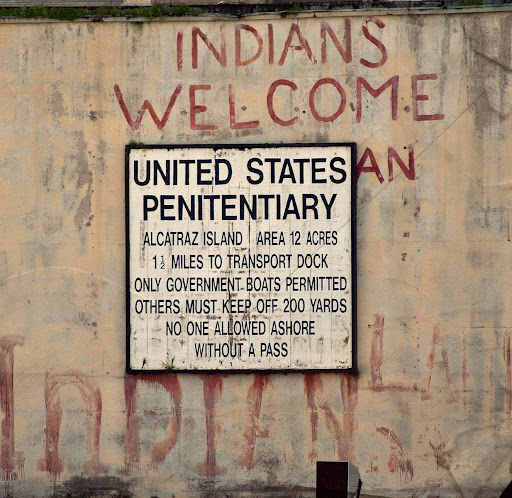Overview
“We Hold the Rock,” Native Activism on Alcatraz

Author: Stephanie Lumsden, PhD (Hupa)
Lesson partner: Rebecca Lowry, Humboldt County Office of Education
Grades: 9-12
Suggested Amount of Time: 55-70 minutes (1-2 class sessions)
Curriculum Themes
- History
- Law/Government
Learning Goals
Students will be able to:
Identify and analyze primary sources by reading historical newspaper articles.
Recognize the multiplicity of perspectives about historical events by contrasting Native peoples' experiences with narrative disseminated by the mainstream media.
Practice creative thinking by working together in small groups to create newspaper headlines from a different point of view.
Lesson Overview
This lesson introduces students to the history of American Indian activism in California and the occupation of Alcatraz Island in 1969-1971. This lesson provides a historical context of resistance on Ohlone homelands since colonial invasion and examines Native activism in the 1970s to demonstrate Native peoples' relationship to their homelands, their fraught legal relationship with the United States, and their prior existing and more legitimate sovereignty. This lesson expands on students’ knowledge of history, their critical thinking skills, and media literacy skills by inviting them to examine primary sources with interactive activities.
Essential Questions:
Where is Alcatraz island? Whose homeland is it part of?
What factors led to the Native American reclamation and occupation of Alcatraz?
How was the Native American occupation of Alcatraz depicted in the media at the time it was happening?
What were some dissenting views and opinions of the occupation of Alcatraz amongst Native peoples?
What is the lasting significance of Native activism on Alcatraz for Native peoples in California and beyond?
Practices:
The teacher must understand the importance of highlighting intertribal political activism on occupied California Indian homelands.
The teacher must be prepared to actively engage students with questions and coach them through how to read primary sources critically.
Learning Targets for students:
I can understand that newspapers and news reels are crafted narratives rather than objective truths.
I can work with a group to be creative and imagine alternative headlines from different points of view.
I can create useful and thorough notes after reading a personal narrative of an historic event.
Teacher Background
Alcatraz Island has long been a significant site for Native peoples. As part of Ohlone homelands it was stewarded by Indigenous peoples for thousands of years until the invasion of the Spanish and the establishment of Mission San Francisco de Asis. The United States stationed a military fort on Alcatraz in 1857 as part of the American invasion and occupation of Ohlone homelands. The military fort at Alcatraz also had a prison where Native resistance fighters were incarcerated for defending their people and for refusing to send their children to Indian boarding schools. Alcatraz was a federal prison from 1934-1963 until it was abandoned as surplus federal land. Meanwhile, in the 1950s the federal Indian policies of Termination and Relocation led to thousands of Native Americans relocating to cities like San Francisco. Native Americans who moved to San Francisco and other cities often experienced poverty, racial discrimination, gender violence, and political disenfranchisement which led to widespread social unrest in the 1960s. In San Francisco, Native students reclaimed Alcatraz as Indian Land and organized it into a group called Indians of All Tribes in November of 1969. The 19 month occupation of Alcatraz by Native American activists, including California Indians, is an important symbol of Native political resurgence. Every Thanksgiving Native peoples and supporters gather on Alcatraz for a sunrise ceremony to honor ancestors and Native resistance.

